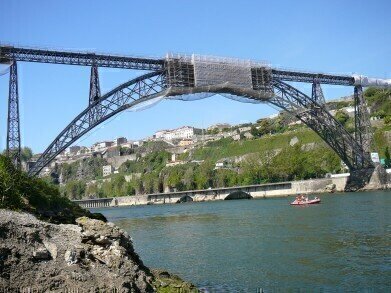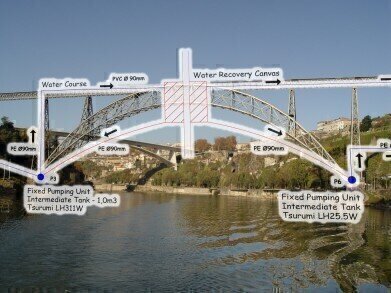Water/Wastewater
Pumps Play a Central Role in Cleaning National Monument
Apr 03 2010
Cleaning any object of historical or national significance requires precise care and attention and the right tools for the job. This applies even when the object in question is a bridge spanning 344m, sitting 60 m above a river. Add in some strict rules on environmental damage and the challenge looks daunting. But with the help of Tsurumi pumps the landmark Maria Pia Bridge in Porto, Portugal got a fresh clean look and an impressive 98% of water used in the task was removed without disappearing into the nearby waterways.
Reducing environmental impacts is a major theme not only in modern construction, but also in maintenance. Much time is devoted to assessing different methods to find the most eco-friendly and efficient solution.
This was the case in Porto, northern Portugal, where the 133 year old Dona Maria Pia Bridge needed to be cleaned. The bridge is a national monument, designed by legendary French engineer Gustave Eiffel before he went on to build France’s most famous landmark, The Eiffel Tower. Its historical significance meant REFER, the government body responsible for managing railway infrastructure who commissioned the work, had to be sure that no damage would be done to the structure. It insisted that any cleaning process must have the lowest environmental impact.
After exploring a variety of options, the ideal solution was found. Industrial cleaning experts Montaco used a high-pressure water system to clean the bridge and a tailor-made water recovery system to collect the water used in the process. Central to the entire set up were a network of Tsurumi pumps, from the company’s LH and KTZ series.
“Our pumps are known for their versatility and ease of use,” says Takanori Yoshida, project manager at Tsurumi Europe. “But this is probably the first time they played a central role in cleaning a national monument. However their robust design, effective performance and proven reliability mean they suit just about any need. On projects around the world our pumps have a record of meeting and surpassing requirements no matter what the job.”
The high pressure water system
Because of the age of the bridge and the importance of maintaining its appearance, the use of chemical cleaning agents was banned. Water was the only viable option as a cleaner. To provide the water, Montaco set up a network of portable jets and hoses fed by water-carrying trucks positioned on the bridge. Two Tsurumi LH series high-head pumps positioned by reservoirs at the foot of the bridge’s two main supports then delivered the used water back up to the trucks to be reused. The portable jets maneuvered the length of the 344 m until cleaning was complete.
The water recovery system
One of the most important parts of the maintenance was minimizing its environmental impact. To do this, a novel water recovery system was installed, which involved a large canvas being placed along the entire underside of the bridge. This canvas collected the water used for cleaning as well as dirt, old paint and rust that was removed in the cleaning process. This residue was then delivered to the two reservoirs and from there three of Tsurumi’s KTZ dewatering pumps transported the contaminated water to a portable 20,000 litre wastewater treatment plant nearby.
“The canvas collection sheet combined with the Tsurumi pumps was a highly effective method and 98% of the water used for cleaning was collected, which is incredible,” says Nuno Paiva, mechanical engineer at local rental company SGSV, Lda. the company that supplied the pumps and managed their use on the project. “The cleaning company, Montaco, has worked with us before and knows the quality that Tsurumi pumps offer. We used to offer other pumps but for the past five years we have only worked with Tsurumi. We get a great response to them; they are user friendly, perform effectively and there is hardly ever a need for spare parts or repairs.”
The pumps
On the Dona Maria Pia Bridge project, choosing the right pumps took account of three key factors. First, reliability — work had to be completed on time. Second, effective operation — the pumps had to operate effectively at 60 m heads for eight to ten hours a day, six days a week for a period of seven months. Third, strength — the pumps had to deal with dirt, rust, metal and parts of wooden railway sleepers without clogging or breaking down. In each of these three key areas, Tsurumi excelled.
SGSV purchased all the pumps through Hidrovento Lda., Tsurumi’s exclusive distributor in Portugal. Hidrovento Lda. supplied one LH series pump, a high-head dewatering pump used in construction and deep-well applications, together with three KTZ series pumps, cast-iron submersible dewatering pumps used in general drainage applications. Both pumps have built-in agitators to reduce the chance of blockage, allowing abrasive materials to pass through without delay.
Both the LH and KTZ series are part of Tsurumi’s contractor pump range, which have a unique dry-running capability. Where most other pumps require a continual flow of water to remain cool, Tsurumi’s pumps feature a patented lubrication technology and will not burn out under dry operation.
Events
May 05 2024 Seville, Spain
May 13 2024 Munich, Germany
May 23 2024 Beijing, China
May 23 2024 Beijing, China
Jun 10 2024 Algiers, Algeria














